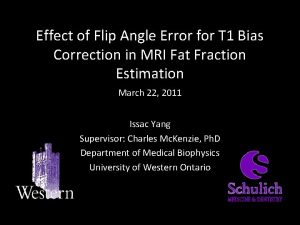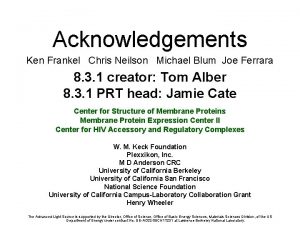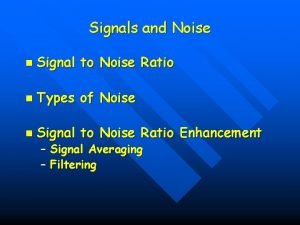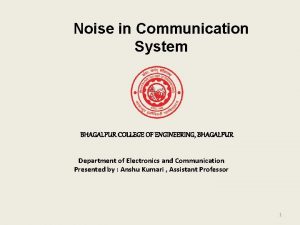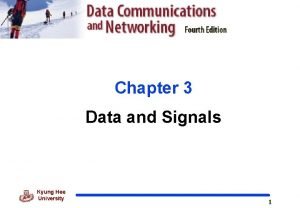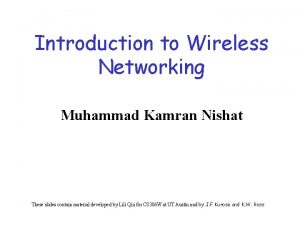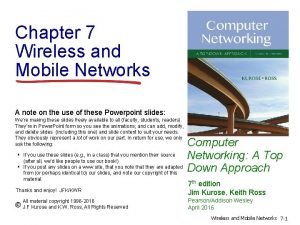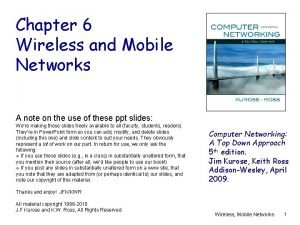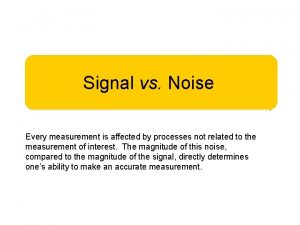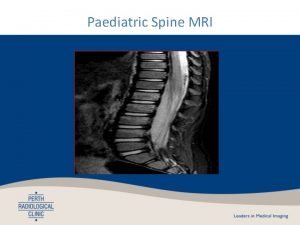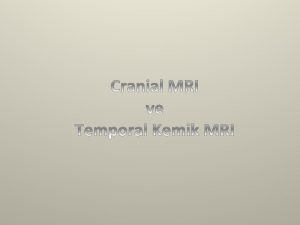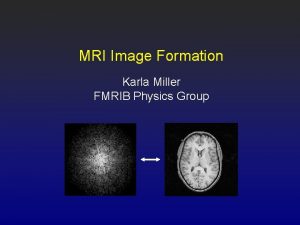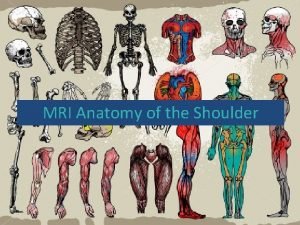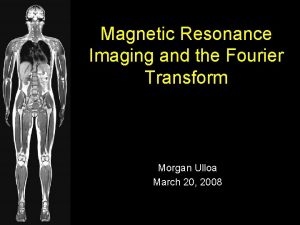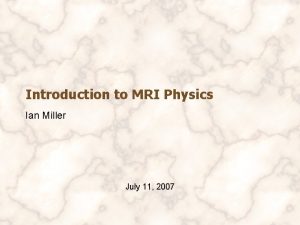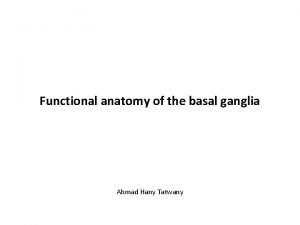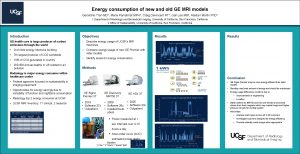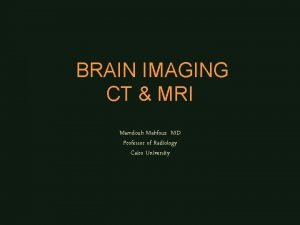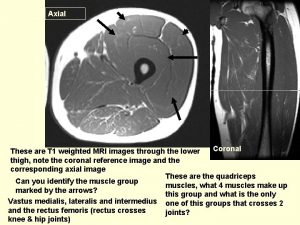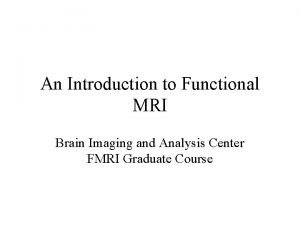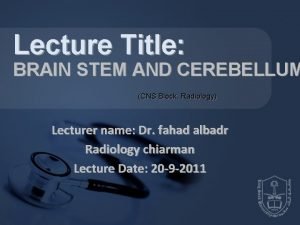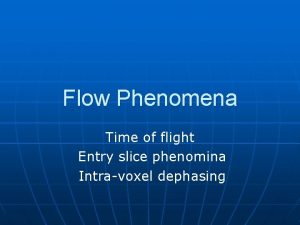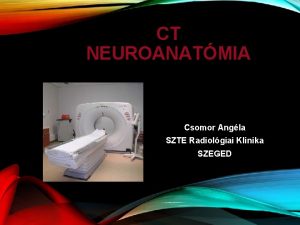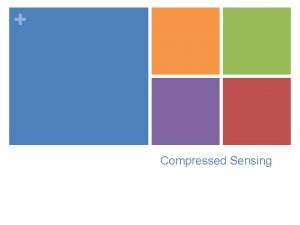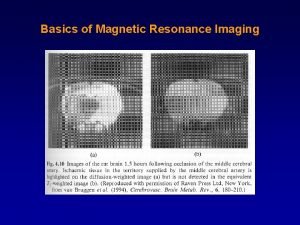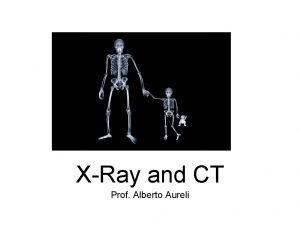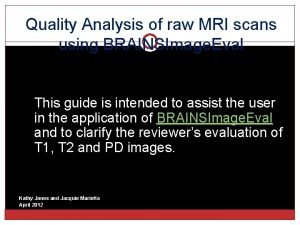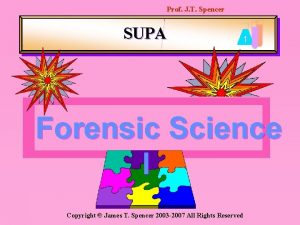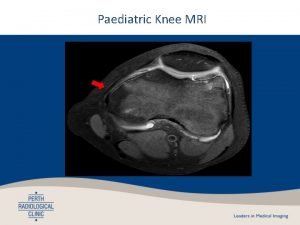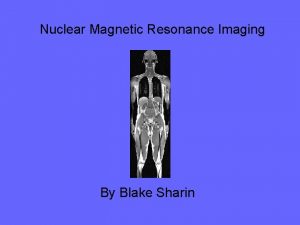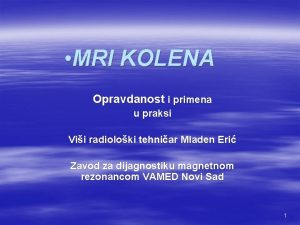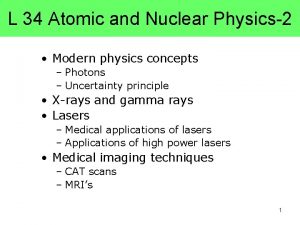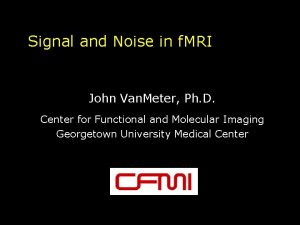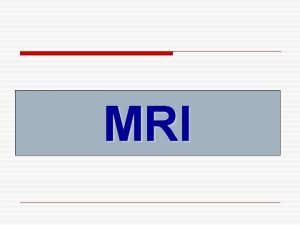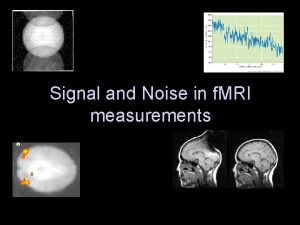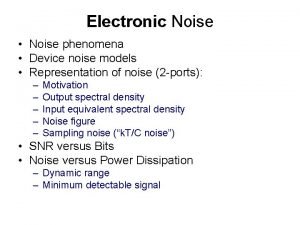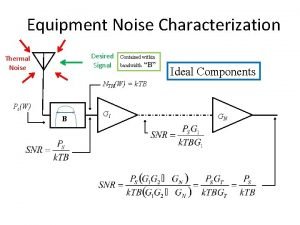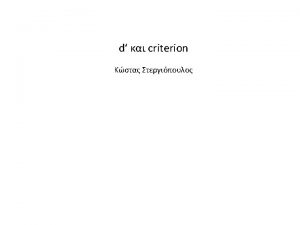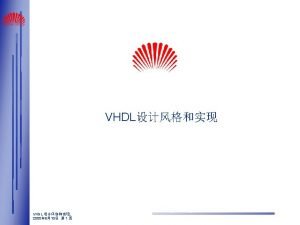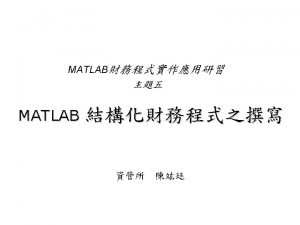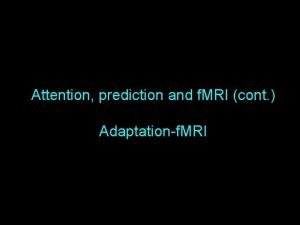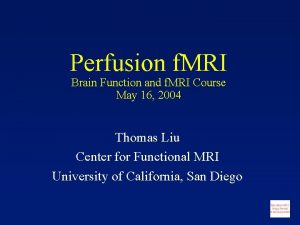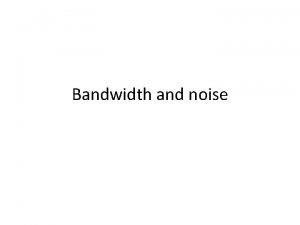Signal and Noise in f MRI John Van

















































- Slides: 49

Signal and Noise in f. MRI John Van. Meter, Ph. D. Center for Functional and Molecular Imaging Georgetown University Medical Center

Outline • Definition of SNR and CNR in context of anatomic imaging • Definition of functional SNR • Sources of noise in MRI • Source of noise in f. MRI • Changes in MRI SNR and functional SNR with increased magnetic field strength

MRI Signal and Noise • Signal is primarily dependent on number of protons in the voxel • Noise can come from RF energy leaking into the scanner room, random fluctuations in electrical current, etc. • The body creates noise in the MR signal via changes in current in the body producing small changes in the magnet field; breathing can change homogeneity

Measuring MRI Signal-to-Noise Ratio (SNR) • Signal is the intensity (brightness) of one or more pixels in the object of interest. • Noise is the intensity of one or more pixels in the ‘air’ (i. e. outside the object of interest). SNR = Signal Noise (low SNR = grainy, fuzzy images) • Fundamental measure of image quality

MRI SNR – Example 1 S = 700 N = 20 SNR = 700 / 20 = 35 S N

MRI SNR – Example 2 S = 300 N = 50 SNR = 300 / 50 =6 S N

MRI SNR - Side-by-Side SNR = 35 SNR = 6

SNR in Terms of f. MRI • MRI SNR is not the most important issue with regard to functional MRI • Functional SNR is contingent on ability to detect changes in BOLD signal between conditions (across time) • Underlying MRI SNR still important in terms of providing base for signal in functional SNR but several other factors affect signal and noise in f. MRI data

Affect of MRI SNR on Functional SNR • Increase in MRI signal due to BOLD affect “rides on top” of signal of in MRI scan • Imagine 2% increase in signal between these two f. MRI scans • In which image will the 2% change be more detectable?

Changes in BOLD Signal are Small • Visual and sensorimotor areas percent change might be as high 5% • For most other cortical areas expected percent change is on the order of 1 -3%

Measuring Percent Signal Change

MRI Contrast-to-Noise Ratio (CNR) • Measure of separation in terms of average intensity between two tissues of interest • Defined as difference between the SNR of the two tissues (A & B): CNR = Signal. A – Signal. B Noise

MRI CNR – Example 1 SW = 700, SG = 200 N = 20 CNRWG = (700 – 200) / 20 = 25 SW SG N

MRI CNR – Example 2 SW = 200, SG = 100 N = 50 CNRWG = (200 – 100) / 50 =2 SW N SG

MRI CNR Side-by-Side SW SW SG SG N N CNRWG = 35 CNRWG = 6

Functional CNR vs Functional SNR • Generally CNR is unimportant in f. MRI as there is little contrast between tissues • Some researchers refer to difference between “On” and “Off” as dynamic CNR or functional CNR • Probably more accurate to refer to ability to detect changes related to activity as functional SNR

• Functional SNR is a dependent on differences in signal across time • Ability to distinguish differences between different conditions - effect size

Differences Between Two Conditions • Typically compare BOLD signal in the same area under different conditions • Example fusiform face area; responds to both faces and tools but about 0. 2% more to faces


Sources of Noise in f. MRI Data • System noise – Thermal noise – Signal drift • • • Subject dependent noise Physiological noise Variability in BOLD response Variability across sessions within subject Variability across subjects

Thermal Noise • Intrinsic noise due to thermal motion of electrons – In subject – In RF equipment • Increases with temperature - atoms move faster; more collisions; greater loss of energy • Unfortunately increases with field strength approximately linearly • Effects limited to temporal fluctuations and is equally likely to add or subtract thus roughly Gaussian (i. e. normally) distributed

Signal Drift Across Time • Magnetic field has slight drifts in strength over time produces drift in signal • Gradually, over time the MRI signal in a voxel drifts • This drift can vary from one voxel to the next both in degree and direction!

Signal Drift

Affect of Signal Drift

Effect of Nonlinear Drifts

Physiological Noise • Subject movement during scan – Single largest source of noise in f. MRI data – Extremely problematic if motion is timed with task – Makes studies with overt speech during the scan quite difficult – Motion more problematic across time points

Subject Motion

Pulsatile Motion of Brain • Influx of blood into brain induces movement especially around base of brain - why there? • Short TR’s can also pick-up noise due to respiration (TR<2500 ms) and cardiac (TR<500 ms) cycle

• Map showing standard deviation of intensity over time • Two sources of noise evident • Why do edges of brain show large effect? • Often referred to as “ringing”

Power Spectrum

Other Sources of Physiological Noise • Change in CO 2 - hyperventilation produces change in O 2 content of blood; blood flow increases to compensate • Drug affects - antihistamines, etc • Smokers vs. Non-smokers – Hypoactivation on attentional task after abstaining for 1 hr reversed following nicotine patch (Lawrence et al, 2002)

Genetic Based Differences • Apo. E risk factor for Alzheimer’s disease • Study of nonsymptomatic carriers • Reduced activation in hippocampus on a memory task for high risk carriers (AS Fleisher, et al, Neurobiology of Aging, 2008)

Noise from Neural Activity Not of Interest • Eye movements - results in activation of the frontal eye-fields • Noise of the scanner - activates auditory cortices – Usually not a problem as noise common to both conditions – Auditory experiments difficult though • Other thoughts - what’s for dinner, going over a to-do list, wondering what the experiment is testing (grad students), etc

Behavioral and Cognitive Variability • Passive tasks are prone to drift in subject attention and/or arousal – Difficult to identify performance on tasks and compare across subjects • Tasks with responses can lead to variations in reaction/response time – Speed-accuracy trade-off • Task strategies used can differ • Task difficulty especially between groups of subjects very problematic

Inter-Subject Variability

Inter-Session Variability

Intra-Session Variability

99 -Scanning Sessions • Same subject participated in 99 identical scanning sessions • 33 each for motor task, visual task, and a cognitive task • Everything kept exactly the same • Considerable variability was observed

33 Motor Sessions Mc. Gonigle, et al. , Neuroimage, 2000

33 Cognitive Sessions

Strategies for Dealing with Noise & Improving Signal • MRI Center Steps – Measure stability of signal over time – Ensure stability of equipment – Eliminate RF-noise • Researcher – – Formalize instructions (use scripts) Train subjects ahead of time Instruct subjects to use same strategy Stress importance of staying still, focus, etc. • Use better post-processing techniques • Increase field strength

Post-processing Pre Post Smith, et al. , Human Brain Mapping, 2005

Signal Averaging • Averaging across multiple trials greatly helps to improve SNR • Each graph shows 20 traces of 1 trial, average of 4 trials, average of 9 trials, etc

Increasing MRI Signal with Stronger Magnets • Increase magnetic field strength – Plus: • more protons pulled into alignment thus greater net magnetization resulting in increased MRI signal – Minus: • shortens T 2* resulting in larger spatial distortions with gradient echo sequences • Requires larger RF pulses thus SAR goes up (why? )

Susceptibility Distortion Increases with Field Strength 1. 5 T 4. 0 T

Rules of Thumb • Quadratic increase in MRI signal with increase in field strength • Thermal noise scales linearly with field strength • Raw MRI SNR thus only scales linearly • What about functional SNR?

Functional SNR Linearly Increases with Field Strength?

Functional SNR vs Field Strength • MRI signal goes up quadratically • Thermal noise goes up linearly • Physiological noise goes up quadratically • Eventually functional SNR expected to plateau

Upsides to Field Strength for Functional SNR • Increase in number of voxels activated and presumably detectability • T 2* of blood much shorter thus signal drops off in larger vessels – Linear increase in large vessels – Quadratic increase in small vessels – Thus, spatial specificity increases
 Fat signal mri
Fat signal mri Quantization noise in pcm
Quantization noise in pcm Frankel signal to noise
Frankel signal to noise S/n ratio
S/n ratio Noise is added to a signal in a communication system *
Noise is added to a signal in a communication system * Baseband and broadband transmission
Baseband and broadband transmission Osinr
Osinr Snr signal to noise ratio
Snr signal to noise ratio Snr signal to noise ratio
Snr signal to noise ratio Signal vs noise
Signal vs noise Baseband signal and bandpass signal
Baseband signal and bandpass signal Baseband signal and bandpass signal
Baseband signal and bandpass signal What is the product of an even signal and odd signal
What is the product of an even signal and odd signal Digital signal as a composite analog signal
Digital signal as a composite analog signal Mri surf2surf
Mri surf2surf Mri gp indications
Mri gp indications Ax t2 propeller mri
Ax t2 propeller mri Image formation mri
Image formation mri Shoulder mri anatomy
Shoulder mri anatomy How mri works
How mri works Mri hydrogen atoms
Mri hydrogen atoms Mri fourier transform
Mri fourier transform Mri physics
Mri physics Lyric hearing aid mri safety
Lyric hearing aid mri safety Capsula interna anatomy
Capsula interna anatomy Geraldine tran
Geraldine tran Haghighat mri center
Haghighat mri center Valuenomics
Valuenomics Pregnancy mri
Pregnancy mri Amegdala
Amegdala First mri image 1973
First mri image 1973 Bingabr
Bingabr Gracilis muscle mri
Gracilis muscle mri Mri ap psychology
Mri ap psychology Lauterbur
Lauterbur Vertical mri
Vertical mri Pons radiology
Pons radiology Entry slice phenomenon mri
Entry slice phenomenon mri Szeged klinika mri vizsgálat
Szeged klinika mri vizsgálat Mri k space
Mri k space Brain stem on mri
Brain stem on mri Angular momentum mri
Angular momentum mri Atri clip
Atri clip Mri scanner
Mri scanner Scan image to text
Scan image to text Jt spencer death
Jt spencer death Mri knee gp
Mri knee gp Disadvantage of mri
Disadvantage of mri Mri kolena
Mri kolena Mri scanner
Mri scanner
